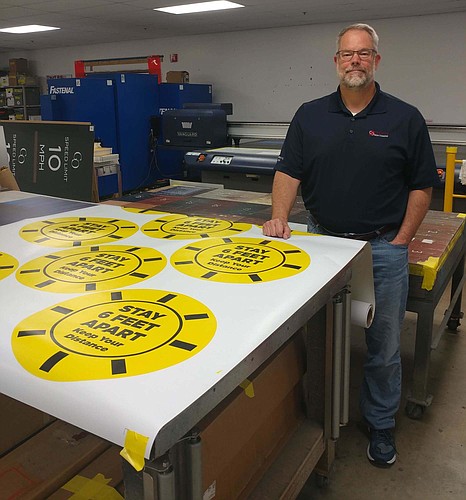- April 4, 2025
-
-
Loading

The pandemic has ushered in a new wave of signage needs.
For restaurants, retail stores, corporate offices and other businesses, signs are a key part of reopening plans. Through signage, companies are communicating crucial messages, from social distancing guidelines to new and altered services.
Area signage companies are working quickly to meet these needs. The key for businesses, officials say, is making signage clear, concise and easy to read. What’s also important? Remembering signage can be used for more than practical purposes. Not only can signs be used to let customers know they are open for business, but they can also be an effective business tool to convey a range of messages, from gratitude to empathy to company values.
Steve Levison, co-owner and president of Manatee County-based Performance Copying & Printing, says his company has been working on a greater quantity of signs and posters during the coronavirus pandemic.
“Print has always been an important medium of communication, and rumors of its death are greatly exaggerated,” Levison says. “It’s playing a key role in communicating during this pandemic.”
Levison says signage about social distancing, along with directional signs and floor graphics, has increased dramatically. Signage can help businesses maximize social distancing by indicating specific traffic patterns through a store. Grocery stores, for instance, have installed signage on its store floors to encourage customers to travel in one direction down aisles. Some businesses have also requested signage to communicate to customers that certain areas of their establishments are closed, such as buffets in supermarkets and restaurants.
Although demand for signage has gone up, it won’t be enough to make up for other business lost during the pandemic. “I think the demand will continue, but it won’t have a dramatic impact on the bottom line to printing establishments,” Levison says. “It’s more of a one-off opportunity than an ongoing opportunity, but it’s obviously very welcome.”
Levison advises businesses to include in reopening plans where they will post signs. He also says messages on signs should be clear and concise, especially for people who haven’t been in the facility or store previously. Companies should consider guidelines and requirements from the CDC, too, plus federal, state and local governments when creating messages.
Businesses can also go beyond the basic and display signs that speak to larger, more emotional concepts. “Businesses need to have the attitude, ‘What can we do to help you, and how can we satisfy you as a customer?’ Because in the end, that’s all that really matters," Levison says.
Like at Performance Copying & Printing, business has been a mixed bag during the pandemic for Tampa-based Creative Sign Designs. “You have some things we’re doing related to the virus itself,” President and CEO Jamie Harden says. “But we’ve definitely experienced some level of slowdown with the economic stall.”
Lately, Creative Sign Designs has worked on signs for health care organizations and corporate offices. Those customers are posting coronavirus-related signs in break rooms, restrooms, lobbies and other areas. “A lot of it is around trying to give some graphics and reminders about what people should be doing,” Harden says.
A common sign subject lately has been reminding people to wash their hands for 20 seconds. He’s also made floor graphics to remind people to remain 6 feet apart — something people wouldn’t have requested in the past, he says. Signs asking people to use hand sanitizer and wear masks have also come up recently.
Harden agrees with Levison: Businesses should harness the power of signage to convey empathy and other cultural, emotional messages. Companies might want to consider adding internal communication signs, for instance, that express gratitude for employees. “I think this is a time to really show thankfulness for your employees and appreciation,” Harden says. “There’s a lot of opportunity for empathy right now.” He’s also seen customers use signs recently to reemphasize their company’s values and mission.
With all kinds of signs, from the more practical to the more value-oriented, Harden says businesses must first answer a key question: “What’s the real point you’re trying to get across?”
He also cautions against doing the same old, same old when it comes to signage. “I think we’re in a new world now,” Harden says. Use colors, shapes or other design elements to capture the attention of a potential customer or to help a patient. “Really try to do something to work to differentiate the brand,” he says. “I think that’s going to be a critical element in this rebuilding time — differentiating.”